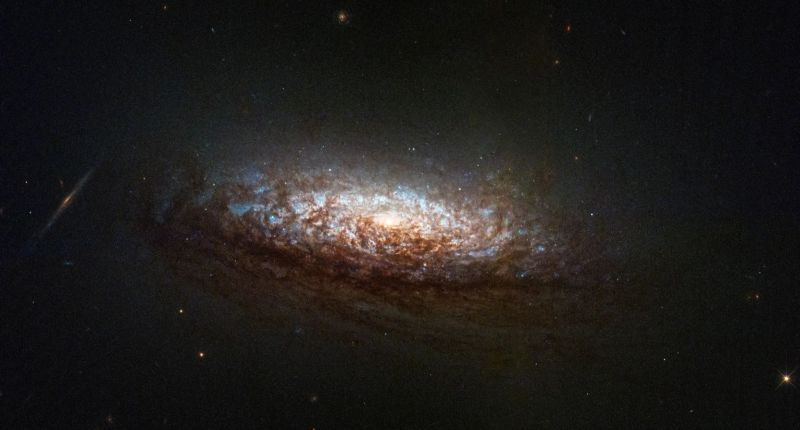After Space Shuttle Atlantis’ drive-by repair of the Hubble Space Telescope (HST) in May of 2009, the end of the STS program meant that the space telescope had to fend for itself with no prospect for any further repair missions. The weakest point turned out to be the gyroscopes, with of the original six only three functioning until May 24th of 2024 when one failed and couldn’t be reset any more. To make the most out of the HST’s remaining lifespan, NASA decided to transition again to single-gyroscope operation, with the most recent imaging results showing that this enables HST to return to its science mission.
Although the HST has operated with a reduced number of gyroscopes before, while awaiting its (much delayed) 2009 Servicing Mission 4, this time around it would appear that no such aid is coming. Although HST is still very much functional even after recently celebrating its 34th year in space, there is a lot of debate about whether another servicing mission could be organized, or whether HST will be deorbited in a number of years. Recently people like [Jared Isaacman] have suggested ideas for an STS servicing mission, with [Jared] even offering to pay for the entire servicing mission out of pocket.
While there is an argument to be made that a Crew Dragon is a poor substitute for a Shuttle with its big cargo bay, airlock and robotic arm, it’s promising to see at least that for now HST can do what it does best with few compromises, while we may just see Servicing Mission 5 happening at some point before that last gyro kicks the bucket.
















As I understand, the gyros are used mainly for measuring and controlling during large scale orientation changes. This process now takes longer, as they rely on star trackers that were not fast enough and such.
The measurement systems for fine guidance (by cameras) as well as the actuators (electromagnet against earths magnetic field and reaction control wheels) for actually executing a change in orientation are not affected.
So – once you found your target, the missing gyros are not a big problem any more.
Still – fascinating to see inaccessible legacy systems to be changed to do things not originally planned.
The article is incomplete without a great video from Scott Manley https://youtu.be/Ra2IpumLMfs?si=XD1K88dFvpyLRlkC
I wonder if they considered Fibre-optic gyros, or if they did consider them, what was the reason for going with a mechanical gyro.
Although it was launched in the 90s, it was designed back in the 70s. The first fibre gyros were just being made mid to late seventies. Maybe they just didn’t make it into the design in time. Hubble had a lot of delays
Did you know that there is better tech now : https://en.wikipedia.org/wiki/Hemispherical_resonator_gyroscope
They do look interesting and have a good track record. I look forward to the day when I can by used HRGs on ebay for a $100.
A fiberoptic gyro is a sensor, not an actuator.
Why would that matter?
I don’t believe the existing/failing sensors are actuators. Perhaps you are thinking of the reaction wheels?
How about just replacing it with a brand-new copy? Building the second one would surely be cheaper, assuming that didn’t happen already.
But perhaps, being designed for Shuttle, it can’t be launched on an unmanned rocket.
Just how cheap do you think “launching a new telescope even of only the Hubble’s capabilities” would be? Compare to continuing using Hubble even in its reduced capabilities.
The Hubble space telescope was built in the 1980s. Everyone who worked on it is probably retired by now. Plans may be missing, and there are certainly components which were common back then but which are no longer in production now.
You’d want to update the electronics and all the computer equipment, and probably improve the optics and the hardware.
At that point, you might as well just design a new one using today’s technology.
It’s not like there’s a fully functional spare (or a warehouse full of them) somewhere that you can just order up another one and schedule a flight with SpaceX.
And you didn’t address the bigger problem, actually getting there to fix it, then actually repairing it.
I recall reading that the hubble was designed around a used spy satellite parabolic mirror, because they were donated two of them for free from a classified program in the National Reconaissance Observatory (NRO). this mirror made up half the cost of the telescope.
If you were going to build one from scratch you certainly wouldn’t duplicate unobtainium components
There were two mirrors made for the Hubble telescope. Both custom made for Hubble. There were no “spare spy satellite” parts involved.
https://en.wikipedia.org/wiki/Hubble_Space_Telescope#Optical_tube_assembly
A company named Perkin-Elmer made the one that was installed in the Hubble telescope. Kodak made another one at the same time in case of a catastrophic failure of the Perkin-Elmer manufacturing process.
There actually was an error in the Perkin-Elmer process. It was not catastrophic so it wasn’t discovered until the Hubble was in orbit.
I bet they used a rig set up to test spy satellite mirrors, and forgot to change for the different focus (not at infinity).
Nope.
Perkin-Elmer was using a test setup designed and built specially for the Hubble mirror. Something was wrong with it, and a technician did a “get ‘er done” and put in some regular washers to “fix it.”
The regular test equipment (that wasn’t as accurate as the custom one was supposed to be) showed the error, but it wasn’t accepted.
https://hackaday.com/2020/04/29/test-equipment-shim-washers-and-a-30-year-old-space-telescope/